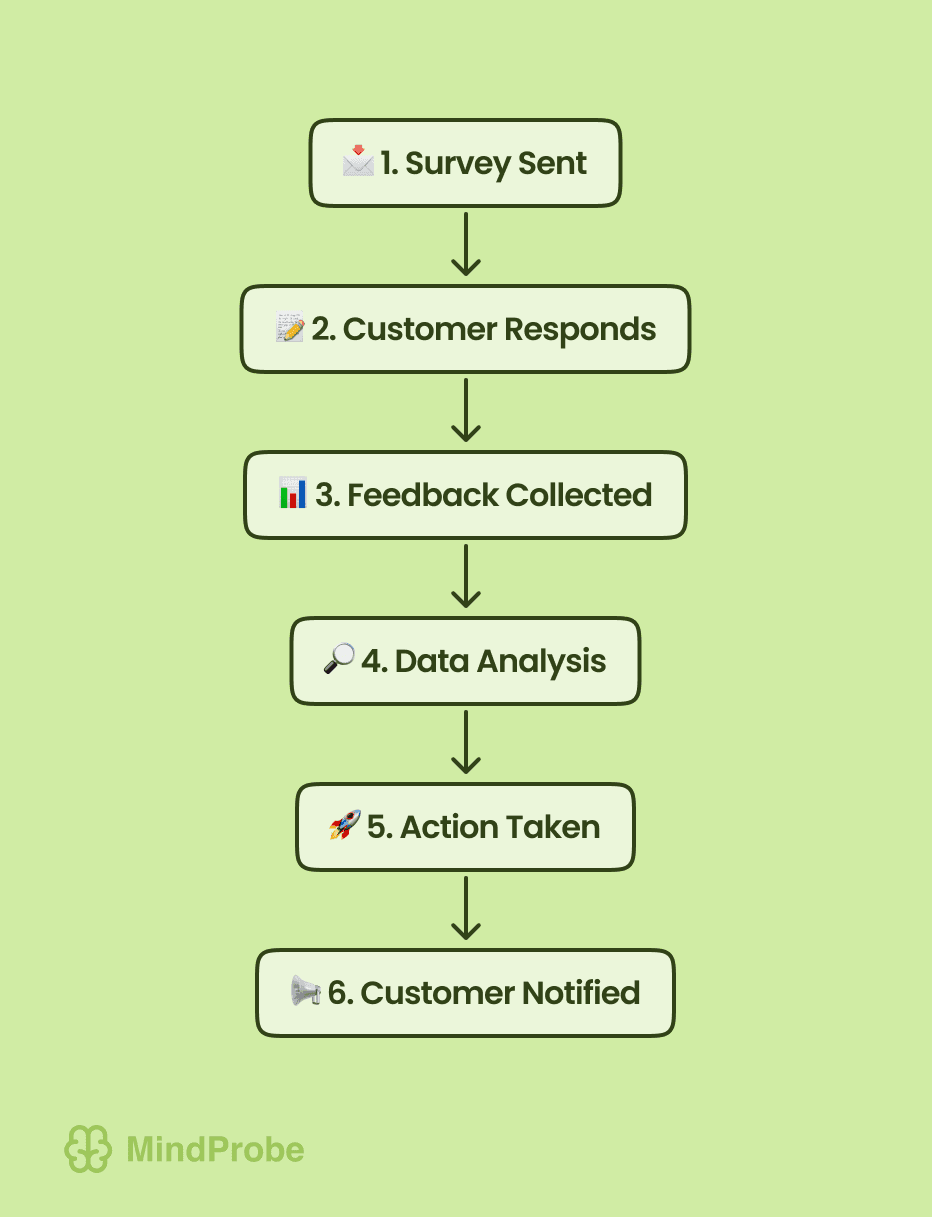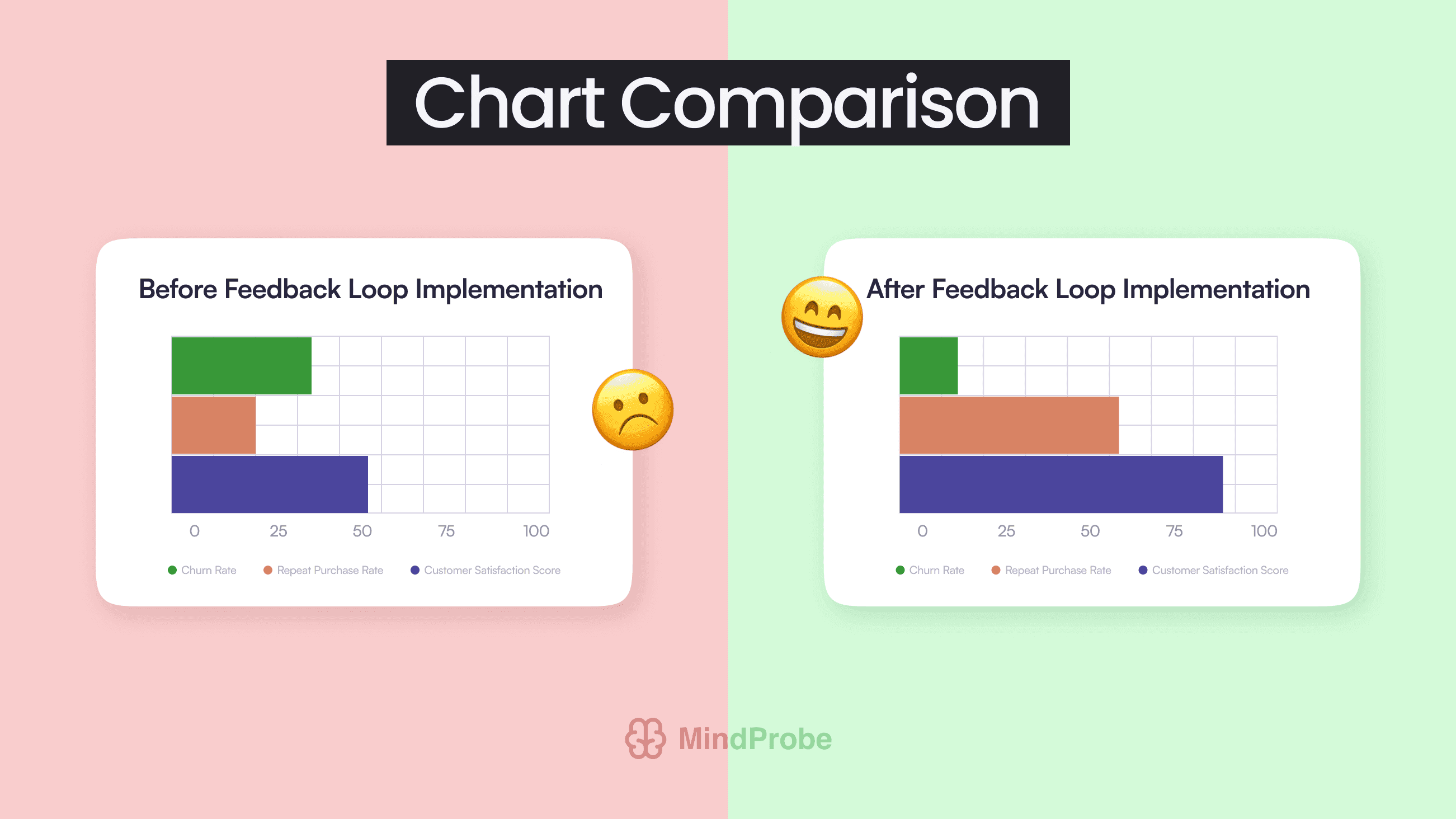Effective Feedback Loops: Keeping B2C Customers in the Conversation
Samee

Discover how to create effective feedback loops that keep your B2C customers engaged. Learn best practices for survey design, implementing changes, and how MindProbe’s AI-driven platform can help.
1. Introduction
Consumer expectations evolve rapidly in today’s B2C landscape, and companies that fail to listen risk losing the competitive edge. Yet, simply collecting feedback isn’t enough - closing the loop by translating those insights into meaningful actions is what truly differentiates brands that foster long-lasting customer relationships. An effective feedback loop ensures that the conversation with your audience is continuous, dynamic, and leads to tangible improvements.
In this in-depth guide, we’ll explore the concept of feedback loops, discuss why they’re so crucial for B2C businesses, and detail how to design, implement, and sustain them. Along the way, we’ll show how MindProbe - an AI-powered market research platform with advanced features like auto-tagging and sentiment analysis - can streamline the entire process, helping you collect, analyse, and act on customer feedback to keep your brand on the path of continuous improvement.
2. Understanding the Concept of Feedback Loops
A feedback loop is a cyclical process where an organisation regularly requests input, interprets the findings, makes adjustments, and then communicates those adjustments back to stakeholders. In a B2C context, this often involves:
- Initiating a survey or other feedback mechanism (e.g., social media polls, in-app prompts).
- Collecting and analyzing data from customers.
- Implementing changes based on insights gained.
- Following up with customers, demonstrating how their input shaped the outcome.
Over time, continuous feedback loops build trust by showing customers that their voices are genuinely heard and valued —not just once, but on an ongoing basis. Each loop reinforces the relationship, making consumers more likely to engage in future feedback opportunities, thus creating a virtuous cycle of listening, learning, and responding.
3. Why Feedback Loops Are Crucial in B2C Markets

1. Rapidly Changing Expectations
- Today’s consumers switch brands if they sense a misalignment between what they need and what’s provided. Feedback loops catch shifts in demand early, so you can pivot quickly.
2. Competitive Differentiation
- Brands that prove they listen and respond to customer input create stronger emotional bonds. This leads to higher brand loyalty, repeat purchases, and positive word-of-mouth.
3. Innovation and Product Refinement
- Direct feedback uncovers hidden pain points or wishlist features. By iterating based on real-world usage, you reduce guesswork and accelerate product-market fit.
4. Conflict Resolution & Retention
- Proactively seeking and addressing issues stops small concerns from escalating into churn. A seamless feedback loop encourages disgruntled customers to voice complaints early, rather than silently leaving.
Designing Surveys to Power Your Feedback Loop
Surveys are the most common mechanism for initiating feedback loops because they can be distributed widely, tailored to specific segments, and easily analysed. However, not all surveys are equally effective. Follow these tips to ensure your questionnaires feed directly into a robust loop.
5.1 Aligning with Specific Goals
- If your objective is to reduce churn, focus on what leads customers to discontinue their relationship.
- If you want to refine features, zone in on usability, value proposition, and pain points.
5.2 Crafting Objective, Targeted Questions
- Avoid leading questions that push respondents toward a certain answer.
- Use consistent rating scales and allow open-ended responses to capture unpredictable viewpoints or innovations you hadn’t considered.
5.3 Mixing Quantitative and Qualitative Approaches
- Quantitative: Provide quick performance indicators (e.g., net promoter score, rating scales).
- Qualitative: Explore deeper emotions or “why” behind the numbers (e.g., “What would you improve about our app and why?”).

6. Closing the Loop: Acting on Survey Insights
Gathering data is the first step, but real value emerges only after you analyse the data and transform insights into meaningful changes.
6.1 Identifying Quick Wins vs. Long-Term Initiatives
- Quick Wins: Are many respondents complaining about a confusing checkout flow or a missing FAQ section? These can often be fixed rapidly.
- Long-Term Initiatives: More complex issues like rebranding or redesigning entire product lines may require a phased approach. Survey data can guide the roadmap for incremental improvements.
6.2 Communicating Changes to Customers
- Be Transparent: Publish short updates via email or in-app notifications describing which feedback you actioned and the resulting changes.
- Express Gratitude: Thank respondents for their input. This fosters a sense of co-creation and makes them more likely to participate again.
6.3 Iteration: Measuring Impact and Refining Further
- Follow-Up Surveys: After implementing changes, conduct smaller pulse checks to see if satisfaction has improved.
- Data Tracking: Monitor relevant KPIs, like churn rate, average revenue per user, or user engagement - and link improvements back to earlier feedback cycles.
7. Leveraging MindProbe for Robust Feedback Loops
7.1 AI-Powered Sentiment Analysis & Auto-Tagging
Collecting open-ended responses can yield rich insights, but manually sifting through them is labour-intensive. MindProbe ’s sentiment analysis automatically classifies comments as positive, negative, or neutral, spotlighting the emotional undercurrents. Meanwhile, auto-tagging identifies recurring themes or keywords like “shipping times,” “pricing confusion,” or “feature request” so you can quickly see which topics dominate.
7.2 Real-Time Analytics Dashboards
Instead of waiting days or weeks for compiled reports, MindProbe’s live dashboards update as responses flow in. This immediate visibility helps you detect issues or celebrate wins early on, allowing you to adapt your approach or target follow-up surveys swiftly.
7.3 7-Day Trial, No Free Subscriptions
MindProbe offers a 7-day trial to experience its premium features like branching logic, robust analytics, and AI-powered data interpretation without committing to a long-term plan. This approach ensures serious marketers and product owners can test the full capabilities, rather than a limited free tier.
8. Strategies to Sustain Ongoing Feedback Engagement
Feedback loops only work if customers keep participating. Here’s how to maintain excitement and avoid fatigue.
8.1 Reward and Recognition
- Exclusive Content: Offer early access to new features or behind-the-scenes updates for loyal respondents.
- Random Draws: Encourage more people to complete surveys by offering the chance to win gift cards or product upgrades.
8.2 Personalised Follow-Ups
- Email Thank-Yous: A simple message acknowledging their time can go a long way.
- Segmented Updates: If a user specifically mentioned issues with your loyalty programme, show them how you addressed it.
8.3 Multiple Feedback Channels
- Omnichannel Approach: Let customers submit feedback via email, chatbots, social media polls, or website forms.
- Meet Customers Where They Are: Younger demographics might respond best to SMS or in-app prompts, while older segments might prefer email surveys.
9. Real-World Examples of Effective Feedback Loops
9.1 E-Commerce Retailers
Scenario: A fashion brand sees low conversions on certain product lines. They run a survey, discovering that sizing guides are unclear. They quickly update their product pages with a more accurate size chart and clear return policy.
- Outcome: Conversion rates rise, and a follow-up pulse survey confirms that confusion around sizing dropped by 40%.
9.2 Subscription Services
Scenario: A meal-kit provider experiences significant churn. Feedback reveals dissatisfaction with limited meal variety. The brand expands its recipe library and emails customers summarising their new options.
- Outcome: Next month’s churn decreases by 15%, correlating directly with their improved meal offerings.
9.3 SaaS and Tech Platforms
Scenario: A project management tool regularly surveys users after major updates. Negative sentiment around the new interface prompts them to restore certain shortcuts.
- Outcome: They quickly recover user satisfaction scores and maintain high user retention rates, attributing this success to actively closing the feedback loop.
10. Overcoming Common Challenges in Feedback Loop Implementation
10.1 Handling Negative Feedback
- Challenge: Frequent criticism can demoralise teams or overshadow positive comments.
- Solution: Separate constructive suggestions from rants, address repeated pain points immediately, and celebrate small wins whenever possible to keep morale balanced.
10.2 Feedback Overload
- Challenge: If you distribute too many surveys or have an always-on feedback channel, you risk overwhelming both customers and your analytics resources.
- Solution: Curate the process. Use shorter pulse surveys and rely on AI-driven filtering (like MindProbe’s auto-tagging) to triage what’s truly critical.
10.3 Ensuring Organisational Buy-In
- Challenge: Teams might see feedback loops as “yet another project” unless they grasp the ROI.
- Solution: Share success stories like churn decreases or revenue upticks directly tied to feedback-driven improvements. Demonstrating real-world impact cements internal support.
11. Future Trends in B2C Feedback Loops
The landscape of customer engagement constantly evolves, and feedback loops will do the same:
1. Predictive Feedback Loops
- AI could predict potential problems (like churn or dissatisfaction) before they arise, prompting pro-active surveys or interventions.
2. Voice and Video Feedback
- As voice assistants and video calls become more common, brands may incorporate voice-based or video-based feedback loops, requiring new analytics methods.
3. Hyper-Personalisation
- Advanced segmentation will allow you to tailor feedback requests to each user’s history, behaviour, or preferences, improving response relevance.
4. Gamification
- Expect more interactive, game-like experiences to keep customers engaged like quiz-style questionnaires or loyalty points for completion.
12. Conclusion
Effective feedback loops are more than just a mechanism for gathering opinions, they are the lifeblood of customer-centric B2C companies. By closing the loop, you transform raw data into changes that solve customer pain points, enhance product experiences, and strengthen brand loyalty. And when customers see that their voices truly matter, they become active collaborators, fueling a continuous cycle of improvement and innovation.
Yet success hinges on picking the right approach: designing neutral, targeted surveys, acting swiftly on the insights, and transparently communicating every update. Tools like MindProbe streamline each stage, be it distributing questionnaires, auto-tagging open-ended responses, or monitoring real-time sentiment. Ultimately, a well-crafted, technology-enabled feedback loop ensures your brand remains aligned with consumer needs, ready to pivot, and always open to a two-way conversation.
Ready to level up your feedback game? Embrace continuous listening, data-driven iteration, and persistent follow-through. In an era where customer experiences make or break a brand, effective feedback loops can be your secret weapon for building long-term loyalty and driving sustainable growth.